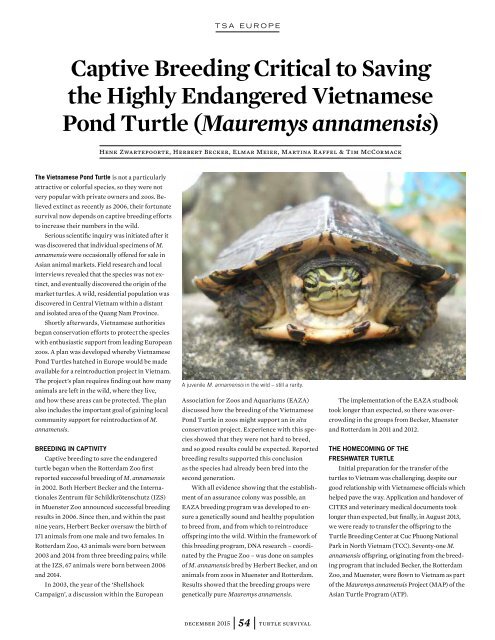Turtle Survival
2tUaeTbNi
2tUaeTbNi
You also want an ePaper? Increase the reach of your titles
YUMPU automatically turns print PDFs into web optimized ePapers that Google loves.
TSA EUROPE<br />
Captive Breeding Critical to Saving<br />
the Highly Endangered Vietnamese<br />
Pond <strong>Turtle</strong> (Mauremys annamensis)<br />
Henk Zwartepoorte, Herbert Becker, Elmar Meier, Martina Raffel & Tim McCormack<br />
The Vietnamese Pond <strong>Turtle</strong> is not a particularly<br />
attractive or colorful species, so they were not<br />
very popular with private owners and zoos. Believed<br />
extinct as recently as 2006, their fortunate<br />
survival now depends on captive breeding efforts<br />
to increase their numbers in the wild.<br />
Serious scientific inquiry was initiated after it<br />
was discovered that individual specimens of M.<br />
annamensis were occasionally offered for sale in<br />
Asian animal markets. Field research and local<br />
interviews revealed that the species was not extinct,<br />
and eventually discovered the origin of the<br />
market turtles. A wild, residential population was<br />
discovered in Central Vietnam within a distant<br />
and isolated area of the Quang Nam Province.<br />
Shortly afterwards, Vietnamese authorities<br />
began conservation efforts to protect the species<br />
with enthusiastic support from leading European<br />
zoos. A plan was developed whereby Vietnamese<br />
Pond <strong>Turtle</strong>s hatched in Europe would be made<br />
available for a reintroduction project in Vietnam.<br />
The project’s plan requires finding out how many<br />
animals are left in the wild, where they live,<br />
and how these areas can be protected. The plan<br />
also includes the important goal of gaining local<br />
community support for reintroduction of M.<br />
annamensis.<br />
BREEDING IN CAPTIVITY<br />
Captive breeding to save the endangered<br />
turtle began when the Rotterdam Zoo first<br />
reported successful breeding of M. annamensis<br />
in 2002. Both Herbert Becker and the Internationales<br />
Zentrum für Schildkrötenschutz (IZS)<br />
in Muenster Zoo announced successful breeding<br />
results in 2006. Since then, and within the past<br />
nine years, Herbert Becker oversaw the birth of<br />
171 animals from one male and two females. In<br />
Rotterdam Zoo, 43 animals were born between<br />
2003 and 2014 from three breeding pairs; while<br />
at the IZS, 67 animals were born between 2006<br />
and 2014.<br />
In 2003, the year of the ‘Shellshock<br />
Campaign’, a discussion within the European<br />
A juvenile M. annamensis in the wild – still a rarity.<br />
Association for Zoos and Aquariums (EAZA)<br />
discussed how the breeding of the Vietnamese<br />
Pond <strong>Turtle</strong> in zoos might support an in situ<br />
conservation project. Experience with this species<br />
showed that they were not hard to breed,<br />
and so good results could be expected. Reported<br />
breeding results supported this conclusion<br />
as the species had already been bred into the<br />
second generation.<br />
With all evidence showing that the establishment<br />
of an assurance colony was possible, an<br />
EAZA breeding program was developed to ensure<br />
a genetically sound and healthy population<br />
to breed from, and from which to reintroduce<br />
offspring into the wild. Within the framework of<br />
this breeding program, DNA research – coordinated<br />
by the Prague Zoo – was done on samples<br />
of M. annamensis bred by Herbert Becker, and on<br />
animals from zoos in Muenster and Rotterdam.<br />
Results showed that the breeding groups were<br />
genetically pure Mauremys annamensis.<br />
The implementation of the EAZA studbook<br />
took longer than expected, so there was overcrowding<br />
in the groups from Becker, Muenster<br />
and Rotterdam in 2011 and 2012.<br />
THE HOMECOMING OF THE<br />
FRESHWATER TURTLE<br />
Initial preparation for the transfer of the<br />
turtles to Vietnam was challenging, despite our<br />
good relationship with Vietnamese officials which<br />
helped pave the way. Application and handover of<br />
CITES and veterinary medical documents took<br />
longer than expected, but finally, in August 2013,<br />
we were ready to transfer the offspring to the<br />
<strong>Turtle</strong> Breeding Center at Cuc Phuong National<br />
Park in North Vietnam (TCC). Seventy-one M.<br />
annamensis offspring, originating from the breeding<br />
program that included Becker, the Rotterdam<br />
Zoo, and Muenster, were flown to Vietnam as part<br />
of the Mauremys annamensis Project (MAP) of the<br />
Asian <strong>Turtle</strong> Program (ATP).<br />
december 2015 54 turtle survival


